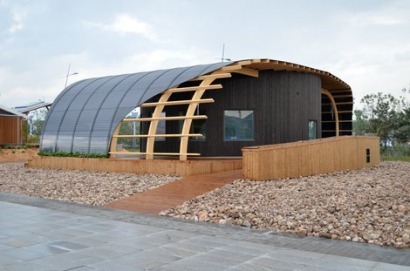
Saudi Basic Industries Corporation (SABIC) has supported “Team Sweden”, a team of graduate students from Chalmers University of Technology, Gothenburg, Sweden, who competed in the 2013 Solar Decathlon China.
SABIC provided the team with its virtually unbreakable, lightweight and flexible LEXAN BIPV (building-integrated photovoltaic) panels which enabled the students to build an award-winning structure that operates purely on solar power.
Green building materials are expected to constitute an approximately $120 billion industry by 2030 and the Solar Decathlon China 2013, held in Datong, is the most recent addition to the international series of Solar Decathlon’s, initially established by the US Department of Energy (DOE). The competitions aim to encourage innovation in the fast-growing solar sector by challenging students to design, build and operate solar-powered houses that are cost-effective, energy-efficient and attractive.
SABIC’s BIPV panels are the first polycarbonate panels to be integrated with PV material and the collaboration with Team Sweden helped to expand the company’s commitment to supporting educational opportunities in the global solar sector, allowing students to imagine and create sustainable designs while driving improved material technologies in the building and construction industry.
“The use of solar power for electricity generation has grown significantly over the last decade, and ‘Team Sweden’s’ work was proof of how innovative materials can enable further adoption of solar power through building integration,” said Michel van Acht, General Manager of Specialty Film & Sheet EMEA region at SABIC. “The LEXAN BIPV panels used on the façade and roofing of the team’s structure not only meet the need for building materials that have integrated photovoltaic capabilities, but also offer cost saving opportunities by being both easier to install and lighter weight than traditional photovoltaic systems.”
The LEXAN BIPV panels enabled Team Sweden to build an energy-efficient and cost-saving structure that could be easily assembled and quickly customized. The students used the panels to construct the façades and roofing of their building, and the flexibility of the material enabled the students to realize their vision of a sweeping canopy roof that encircles a unique communal space, fostering interaction and communication. The unique design and sustainable features of the structure fulfilled the requirements of the competition and led Chalmers University’s Team Sweden to win third place overall after the University of Wollongong (first place) and South China University of Technology (second place).
In addition to being lightweight and flexible, the panels feature built-in PV cells, allowing for the simultaneous installation of roofing and a photovoltaic system. These multiwall BIPV panels are especially unique in that they maintain the performance of the high-efficiency cells in the flexible thermoplastic encasement, reducing energy consumption by up to 17 percent when compared to traditional high-return, double-pane glass glazing. This provides architects and builders with both enhanced design freedom and superior energy production in a single, integrated product.
According to SABIC, the panels also offer excellent cost-saving potential relative to heavy glass panels or standard PV panels. The ability to transport and install the lightweight material quickly and easily without the need of heavy lifting equipment or additional mounting systems offers potential savings on installation time and costs, and the energy-efficient properties enable further cost savings over the panel’s lifespan. Additionally, the panels can be used with a lighter supporting steel framework than glass requires, which may reduce material and shipping expenses. The panels are suitable for roofing, cladding and glazing applications and are also designed to offer excellent thermal insulation properties while also helping to reduce cooling load and glare associated with large expanses of architectural glazing.
Further information:

